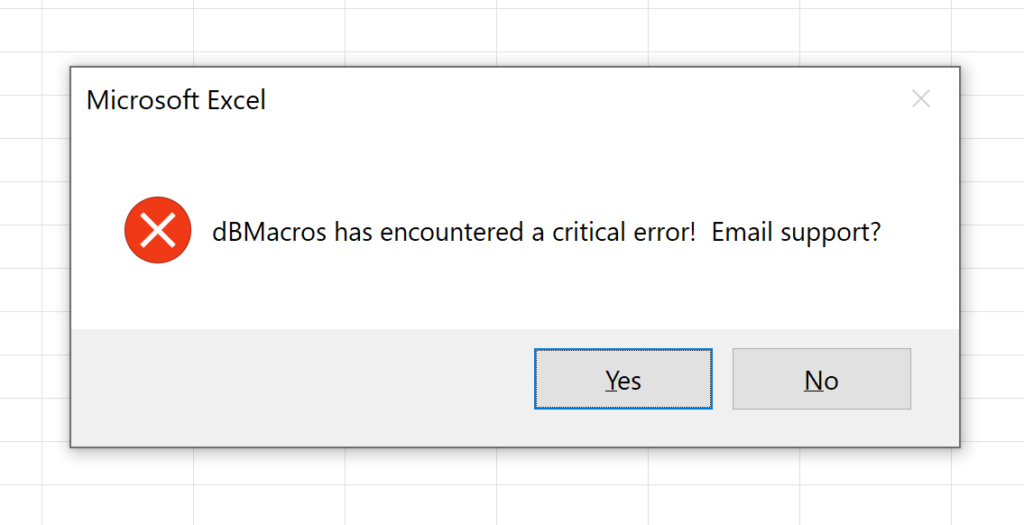Need help?
If your question isn’t answered below, please get in touch.
Have a question about a specific macro?
Please check out the video guides, which discuss all the macros and have timestamps.
Is my Sound Level Meter (SLM) supported?
As long as the data can be opened in Excel, then you should be able to use the results from any sound level meter using the “Raw data (unspecified source)” option.
However, there are a few known SLMs that are specifically programmed for and will process the data with fewer clicks and handle audio files. To read more about specific devices, check out the page: Importing data and known sound level meters
Is it available in other languages?
dBmacros is only available in English and is not guaranteed to work with other languages and number formatting. If you would like support added for a certain language then please get in touch.
Bugs – what to do when things go wrong?
The macros were designed in-house for tasks that are specific to our needs. It’s likely that in the process of using your own data to achieve your own results, that you’ll encounter bugs along the way and see the following error screen:

This usually has happened because of a situation that we haven’t encountered before and didn’t program around. If this does happen, we’re sorry and we want to fix it. Please get in touch and together we can resolve it and improve the macros going forward.
What are the requirements?
The “Time” column
The time column shouldn’t have any gaps between the rows when the time is continuous. A gap is used to indicate that there has been a break in time and a measurement period has ended, such as by stopping and starting the sound level meter.
Other columns
Each subsequent column can contain any variety of data for that time period. The titles will help the macros understand what the data is.
If the data is spectrum data, then the title must include “Hz” in the title along with the centre frequency band value so that the macros can recognise this.
Can it be run on a Mac?
No. It’s not programmed to run on a Mac. If this is something you’d like to see, please get in touch.
There is no undo?
Excel doesn’t automatically add undo for macros – it’s a limitation of Excel.
It is planned to add some undo functionality in the future but for now, just remember to save regularly and rename your file often so you can restore older versions yourself.
It runs too slowly. How can I speed it up?
Sound level data can result in very large files when the meter is set to record at a high resolution, for example 100ms, or over long periods of time. This will result in Excel running slowly as it loads and manipulates all this information.
To prevent your user experience becoming unbearably slow, it’s recommended to limit the data on a worksheet to either 1 hour of 100ms data or 24 hours of 1 second data.
You can divide your worksheet to these limits easily by running the macro “Auto Split Datasheet”.
Excel gets locked with any interaction causing a “beep”?
While Excel is editing in the formula bar, all the ribbon buttons and pop-up windows get locked. When editing the formula bar the following buttons become active:

Hit ESC to exit the formula bar and then you will be able to continue.
Can the Keyboard Shortcuts be disabled?
There is a checkbox to enable/disable the use of the Keyboard Shortcuts. It can be found through the Macros Settings pop-up window.
Is it desktop only? Why VBA? What are the development plans for dBMacros?
The Add-in is programmed in VBA with Excel Userforms for user interaction. The development started back in early 2000s to meet the needs of the Environmental Health Consultancy. Since then Excel has changed a lot. Microsoft is currently focused on cloud-based and browser-based data handling and Office Scripts is the new automation method offered by Excel.
Whilst it will continue to be supported, VBA is no longer being developed by Excel and for this reason the dBMacros experience can feel a bit dated at times. Future development of the Add-in will try to utilise the new technology offered by Excel as much as is possible but currently Office Scripts is too limited in what can be done for dBMacros to be transitioned over. VBA has the necessary user interaction and file management support needed.
The development of Excel over the past decades has done little to improve the plotting of large datasets, as graphing features have instead been focused on small datasets. However, Excel is still a useful way to plot and analyse sound level data for reporting. The kind of sound level data files processed by dBMacros can be very large in size so processing the data locally on a desktop computer, rather than on the cloud, is still the best way to manage the huge files involved.